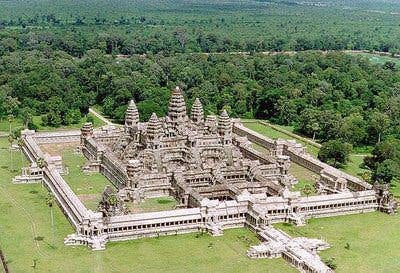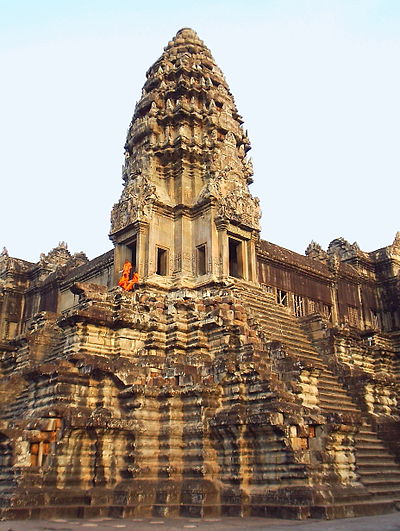Angkor Wat - Cambodia

The Temple
Angkor Wat which means Capital Temple is a temple complex in Cambodia. It is the largest religious monument in the world, with the site measuring 162.6 hectares (1,626,000 m2; 402 acres).
The Angkor Wat temple was originally built as a temple devoted to Lord Vishnu in 12th century by King Suryavarman II. By the end of 12th century it became more of a Buddhist temple. reaking from the Shaiva tradition of previous kings, Angkor Wat was instead dedicated to Vishnu. As the best-preserved temple at the site, it is the only one to have remained a significant religious center since its foundation.
The History
Angkor Wat lies 5.5 kilometres (3.4 mi) north of the modern town of Siem Reap, and a short distance south and slightly east of the previous capital, which was centered at Bhaphuan. In an area of Cambodia where there is an important group of ancient structures, it is the southernmost of Angkor's main sites.
According to legend, the construction of Angkor Wat was ordered by Lord Indra to act as a palace for his son Precha Ket Mealea. According to the 13th century Chinese traveler Daguan Zhou, it was believed by some that the temple was constructed in a single night by a divine architect.
The foundation stone or the Shila as it is called has not been found but the general consensus is that King Suryavarmam II built this temple in the start of 12th century. 27 years after the King's death the Chams, rivals of Khmer attacked the temple and destroyed large portions of it. Jayavarmam VII later restored the temple.
One of the first Western visitors to the temple was António da Madalena, a Portuguese monk who visited in 1586 and said that it
"is of such extraordinary construction that it is not possible to describe it with a pen, particularly since it is like no other building in the world. It has towers and decoration and all the refinements which the human genius can conceive of."
Architecture
The temple follows what is known as Khmer architecture. By the 12th century Khmer architects had become skilled and confident in the use of sandstone (rather than brick or laterite) as the main building material. Most of the visible areas are of sandstone blocks, while laterite was used for the outer wall and for hidden structural parts. The binding agent used to join the blocks is yet to be identified, although natural resins or slaked lime has been suggested.

Architecturally, the elements characteristic of the style include: the ogival, redented towers shaped like lotus buds; half-galleries to broaden passageways; axial galleries connecting enclosures; and the cruciform terraces which appear along the main axis of the temple. Typical decorative elements are devatas (or apsaras), bas-reliefs, and on pediments extensive garlands and narrative scenes.
Tourism
Since the 1990s, Angkor Wat has become a major tourist destination. In 1993, there were only 7,650 visitors to the site; by 2004, government figures show that 561,000 foreign visitors had arrived in Siem Reap province that year, approximately 50% of all foreign tourists in Cambodia. The number reached over a million in 2007, and over two million by 2012. Since then this number has been steadily increasing.
UNESCO has played a major role in conservation and maintenance of this temple since then. It is not only a world heritage site but also one of the most prominent one. For Cambodians it has become a major source of their identity and it features on their flag.
Angkor Tourist City has been developed as a high end tourist destination with luxury hotels and various tourism activities.